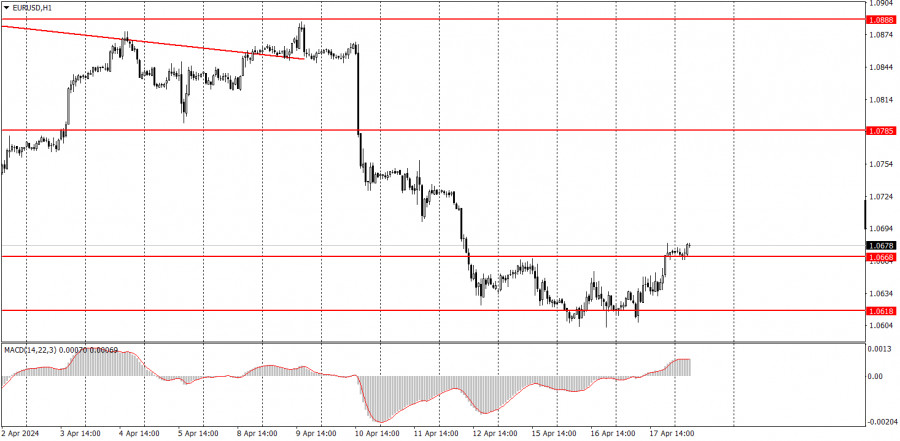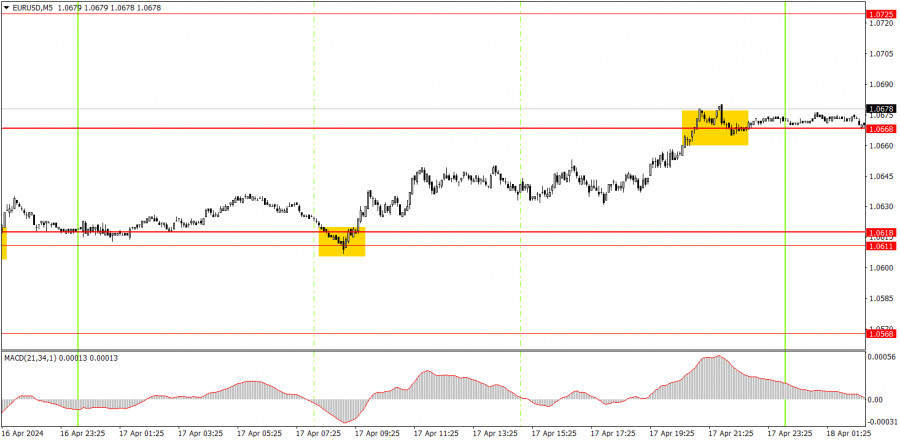Analyzing Wednesday's trades:
EUR/USD on 1H chart
EUR/USD failed to surpass the level of 1.0618 for the third time and eventually started a bullish correction after last week's decline. This isn't exactly predictable since there were hardly any significant macroeconomic or fundamental events yesterday. However, just a day earlier, Federal Reserve Chief Jerome Powell signaled that the central bank will not lower interest rates in June. He said there's been a "lack of further progress" on tackling inflation in the US. Therefore, the interest rates will stay high to return inflation to the Fed's 2% goal.
At the same time, it is almost certain that the European Central Bank will lower rates in June, providing the US currency with an excellent opportunity to continue its upward movement for several more months. Therefore, the fundamental background suggests a downward movement, and what we are witnessing now is merely a standard correction.
EUR/USD on 5M chart
There was one trading signal on the 5-minute timeframe that is worth highlighting. At the beginning of the European session, the price bounced off the range of 1.0611-1.0618, after which it managed to rise to the level of 1.0668 and even surpass it. Therefore, novice traders could open long positions in the morning, which brought them a profit of about 40 pips. Holding above the level of 1.0668 can be used for new long positions, but the current rise is corrective in nature.
Trading tips on Thursday:
On the hourly chart, the downtrend persists. We believe that the euro should fall further, as it is still too high, and in general, the trend is headed downwards. The recent macro data have provided full support for the US dollar. The global fundamental background indicates that the ECB will start lowering rates at the next meeting, while the Fed pushes back its rate cut cycle.
On Thursday, the euro may continue to correct higher since it has surpassed the level of 1.0668. You may consider small purchases. At the same time, sell signals will be more interesting as the pair is following a downtrend.
The key levels on the 5M chart are 1.0483, 1.0526, 1.0568, 1.0611-1.0618, 1.0668, 1.0725, 1.0785-1.0797, 1.0838-1.0856, 1.0888-1.0896, 1.0940, 1.0971-1.0981. There are no significant events scheduled in the European Union today, while the US will only release secondary reports on unemployment claims and new home sales. Most likely, we can expect low volatility again today and, as a result, weak movements.
Basic trading rules:
1) Signal strength is determined by the time taken for its formation (either a bounce or level breach). A shorter formation time indicates a stronger signal.
2) If two or more trades around a certain level are initiated based on false signals, subsequent signals from that level should be disregarded.
3) In a flat market, any currency pair can produce multiple false signals or none at all. In any case, the flat trend is not the best condition for trading.
4) Trading activities are confined between the onset of the European session and mid-way through the U.S. session, after which all open trades should be manually closed.
5) On the 30-minute timeframe, trades based on MACD signals are only advisable amidst substantial volatility and an established trend, confirmed either by a trendline or trend channel.
6) If two levels lie closely together (ranging from 5 to 15 pips apart), they should be considered as a support or resistance zone.
How to read charts:
Support and Resistance price levels can serve as targets when buying or selling. You can place Take Profit levels near them.
Red lines represent channels or trend lines, depicting the current market trend and indicating the preferable trading direction.
The MACD(14,22,3) indicator, encompassing both the histogram and signal line, acts as an auxiliary tool and can also be used as a signal source.
Significant speeches and reports (always noted in the news calendar) can profoundly influence the price dynamics. Hence, trading during their release calls for heightened caution. It may be reasonable to exit the market to prevent abrupt price reversals against the prevailing trend.
Beginning traders should always remember that not every trade will yield profit. Establishing a clear strategy coupled with sound money management is the cornerstone of sustained trading success.











